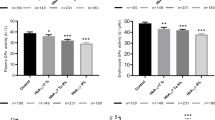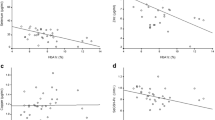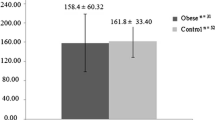Abstract
This study was undertaken to evaluate the levels of plasma magnesium, lipid peroxides, nitric oxide end products, erythrocyte membrane lipid peroxides, erythrocyte reduced glutathione and erythrocyte superoxide dismutase activity in type-2 diabetes mellitus patients. 60 patients with type-2 diabetes mellitus and 30 healthy control subjects were included in this study. Among 60 type-2 diabetic patients, 30 patients were without complication and 30 patients were with various complications. Decreased levels of plasma magnesium, erythrocyte reduced glutathione and erythrocyte superoxide dismutase activity while increased levels of plasma lipid peroxides, nitric oxide end products and erythrocyte membrane lipid peroxides were observed in patients with type-2 diabetes mellitus. We propose that, under the shadow of hypomagnesaemia, there is excessive production of reactive oxygen species and reactive nitrogen species as reflected by elevated lipid peroxides and nitric oxide end products concomitant with dwindled antioxidants and suggest their association with late complications in type-2 diabetes mellitus.
Similar content being viewed by others
References
Joshi SR. Review Diabetes Mellitus (Part 1). Quarterly Medical Review 2003; 55: 1–42.
Pham PCT, Pham PMT, Pham SV, Miller JM, Pham PTT. Hypomagnesemia in patients with type 2 Diabetes. Clin J Am Soc Nephrol 2007; 2: 366–373.
Keenoy BM, Moorkens G, Vertommen J, Noe M, Neve J, Leeuw ID. Magnesium status and parameters of the oxidantantioxidant balance in patients with chronic fatigue: effects of supplementation with magnesium. J Am College of Nutr 2000; 19: 374–382.
Walti MK, Zimmermanna MB, Spinasb GA, Hurrella RF. Low plasma magnesium in type 2 diabetes. Swiss Med Wkly 2003; 133: 289–292.
Hans CP, Sialy R, Bansal DD. Magnesium deficiency and diabetes mellitus. Curr Sci 2002; 83: 1456–1463.
Cai L, Wang J, Yan L, Sun X, Wang L, Zhou Z, Kang YJ. Inhibition of superoxide generation and associated nitrosative damage is involved in metallothionein prevention of diabetic cardiomyopathy. Diabetes 2005; 54: 1829–1837.
Hans CP, Chaudhary DP, Bansal DD. Magnesium deficiency increases oxidative stress in rats. Ind J Exp Biol 2002; 1275–1279.
American Diabetes Association. Screening for type 2 diabetes. Diabetes Care 2003; 26(Suppl 1): S21–S24.
Neill DW, Neely RA. The estimation of magnesium. in serum using titan yellow. J Clin Path 1956; 9: 162–163.
Jain SK. Hyperglycemia can cause membrane lipid peroxidation and osmotic fragility in human red blood cells. J Biol Chem 1989; 264: 21340–21345.
Cortas NK, Wakid NW. Determination of inorganic nitrate in serum and urine by a kinetic cadmium-reduction method. Clin Chem 1990; 36: 1440–1443.
Beutler E, Duron O, Kefly BM. Improved method for the determination of blood glutathione. J Lab Clin Med 1963; 61: 882–888.
Das K, Samanta L, Chainy GBN. A modified spectrophotometric assay of superoxide dismutase using nitrite formation by superoxide radicals. Ind J Biochem Biophys 2000; 37: 201–204.
Hans CP, Sialy R, Bansal DD. Hypomagnesemia in diabetic patients: correlation with oxidative stress. Int J Diab Dev Countries 2002; 22: 122–131.
O’Connell BS. Select vitamins and minerals in the management of diabetes. Diabetes Spectrum 2001; 14: 133–148.
Paolisso G, Scheen A, Cozzolino D, Maro GD, Varricchio M, D’onofrio F, et al. Changes in glucose turnover parameters and improvement of glucose oxidation after 4-week magnesium administration in elderly noninsulin-dependent (type II) diabetic patients. J Clin Endocrinol Metab 1994; 78: 1510–1514.
Nasri H. Lipids in association with serum magnesium in diabetes mellitus patients. Acta Angiol 2006; 12: 149–154.
Barbagallo M, Dominguez LJ, Tagliamonte MR, Resnick LM, Paolisso G. Effects of glutathione on red blood cell intracellular magnesium: relation to glucose metabolism. Hypertension 1999; 34: 76–82.
Slatter DA, Bolton CH, Bailey AJ. The importance of lipid derived malondialdehyde in diabetes mellitus. Diabetologia 2000; 43: 550–557.
Freedman AM, Mak IT, Stafford RE, Dickens BF, Cassidy MM, Muesing RA, et al. Erythrocytes from magnesium-deficient hamsters display an enhanced susceptibility to oxidative stress. Am J Physiol 1992; 262: 1371–1375.
Giugliano D, Ceriello A, Paolisso G. Diabetes mellitus, hypertension and cardiovascular disease: which role for oxidative stress? Metabolism 1995; 44: 363–368.
Howard AB, Alexander RW, Taylor WR. Effects of magnesium on nitric oxide synthase activity in endothelial cells. Am J Physiol Cell Physiol 1995; 269: C612–C618.
Ceriello A, Motz E. Is oxidative stress the pathogenic mechanism underlying insulin resistance, diabetes and cardiovascular disease? The common soil hypothesis revisited. Arterioscler Thromb Vasc Biol 2004; 24: 816–823.
Kowluru RA. Effect of reinstitution of good glycemic control on retinal oxidative stress and nitrative stress in diabetic rats. Diabetes 2003; 52: 818–823.
Bhatia S, Shukla R, Madhu SV, Gambhir JK, Prabhu KM. Antioxidant status, lipid peroxidation and nitric oxide end products in patients of type 2 diabetes mellitus with nephropathy. Clin Biochem 2003; 36: 557–562.
Mak IT, Komarov AM, Wagner TL, Stafford RE, Dickens BF, Weglicki WB. Enhanced NO production during Mg deficiency and its role in mediating red blood cell glutathione loss. Am J Physiol 1996; 271: 385–390.
Freitas JP, Filipe PM, Radrigo FG. Lipid peroxidation in type-II normolipidemic diabetic patients. Diabetes Res Practy 1997; 36: 71–75.
Kuzniar A, Mitura P, Kurys P, Szymonik-Lesiuk S, Florianczyk B, Stryjecka-Zimmer M. The influence of hypomagnesemia on erythrocyte antioxidant enzyme defense system in mice. Bio Metals 2003; 16: 349–357.
Evans JL, Maddux BA, Goldfine ID. Antioxidants in diabetic complications and insulin resistance. In: Raz I, Skyler J, Shafrir E (ed) Diabetes: from research to diagnosis and treatment. Dunitz London, 2003: 479–496.
Author information
Authors and Affiliations
Corresponding author
Rights and permissions
About this article
Cite this article
Ankush, R.D., Suryakar, A.N. & Ankush, N.R. Hypomagnesaemia in type-2 diabetes mellitus patients: A study on the status of oxidative and nitrosative stress. Indian J Clin Biochem 24, 184–189 (2009). https://doi.org/10.1007/s12291-009-0033-y
Published:
Issue Date:
DOI: https://doi.org/10.1007/s12291-009-0033-y




